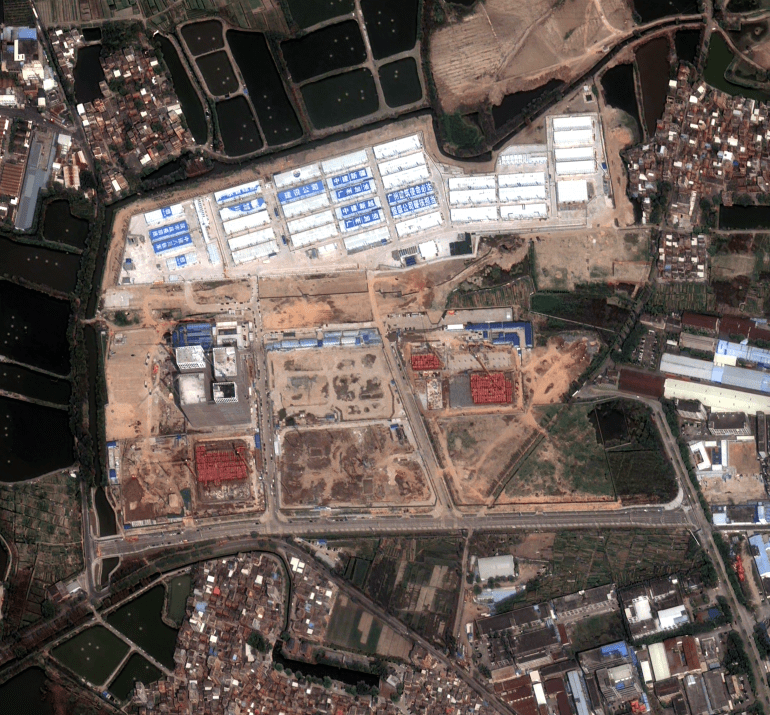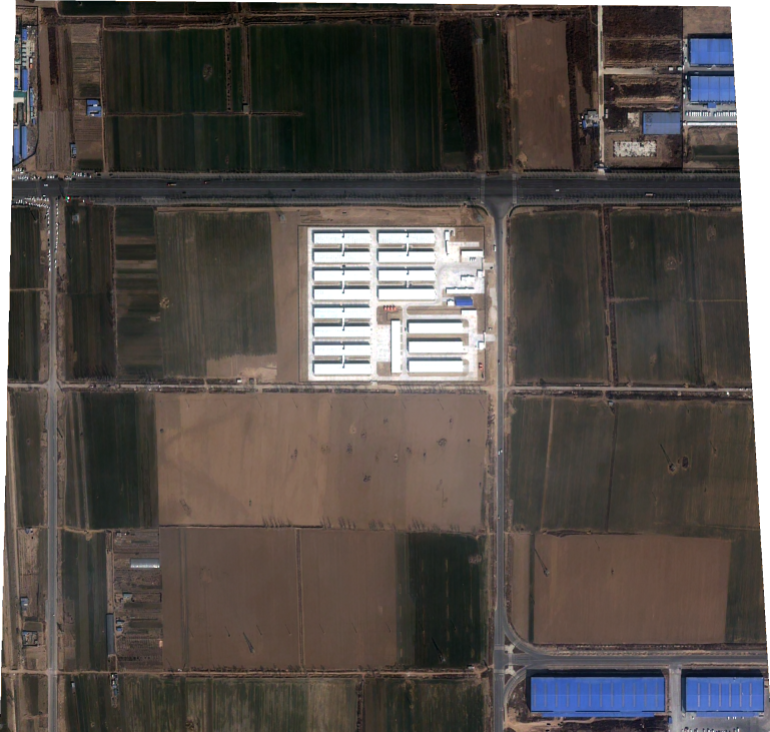Taipei, Taiwan – Nearly four months after China abruptly scrapped its tough “zero-COVID” policies following rare mass protests, authorities have yet to dismantle sprawling quarantine facilities designed for isolating hundreds of thousands of people, an Al Jazeera investigation based on satellite imagery shows.
Mass quarantine facilities in three Chinese provinces appear fully intact with no visible changes to their structure, an analysis of the satellite images shows, raising questions about the Chinese government’s post-pandemic plans for the now-defunct structures.
China’s quarantine facilities, which were previously used to isolate, and at times treat, positive COVID-19 cases and close contacts, became a symbol of the human cost of Beijing’s “zero-COVID” policy, which was dropped in December amid mounting public frustration with the draconian measures.
Beiijng’s overarching plan for its now-defunct quarantine centres, if there is one, is not clear.
Provincial authorities in Guangdong, Shandong and Sichuan did not reply to Al Jazeera’s requests for comment. Efforts to reach the National Health Commission (NHC) were unsuccessful.
In December, however, the NHC called on local governments to “upgrade” quarantine centres into hospitals with facilities including intensive care. The NHC said local authorities should carry out the upgrades with local needs in mind but did not specify the ratio or number of facilities that should be refurbished.
Meanwhile, some local governments have announced plans for a variety of other uses for the centres – from temporary housing to elderly care.

The satellite images obtained and analysed by Al Jazeera’s Sanad investigation unit cover six quarantine centres: three in northern China’s Shandong province, two in Guangdong province on the southern coast, and one in Sichuan in the centre of the country.
The facilities include Guangzhou’s 80,000-person capacity Nansha Health Centre, which was only completed in November. The furthest distance between locations – from the outskirts of Jining in Shandong to Guangzhou in Guangdong – is more than 1,700km (1,056 miles).
Sanad geolocated the quarantine centres using drone footage circulated on social media and analysed satellite images of the facilities taken within the last few days.
The images of quarantine centres analysed by Al Jazeera do not show any structural changes or construction to suggest significant upgrades.
For China, upgrading defunct quarantine centres en masse could potentially be a potentially difficult and costly task.
“Quarantine hospitals are designed in a very different way from acute care hospitals because for quarantine, the main purpose of the facility is to quarantine, not treatment,” Chi Chunhuei, director of the centre for global health at Oregon State University, told Al Jazeera.

While the Chinese government has not published official figures, news reports and official statements suggest that a large number of makeshift structures were erected across the country during the pandemic.
As early as January and February 2020, the National Development and Reform Commission allocated 530 million yuan ($77m) to quickly build two prefabricated COVID-19 hospitals in Wuhan, the then epicentre of the pandemic. China State Construction allocated another 500 million yuan (72.6m) to the project, which was modelled after a makeshift hospital built during the SARS pandemic in 2003.
The two facilities were dismantled in April 2020 as China began to contain the first COVID wave but the model would be widely adapted again two years later in the midst of an even larger infection wave in the spring of 2022.
As authorities struggled to contain the virus once again, local and city governments got to work to flatten the curve and ultimately achieve zero cases.
Chinese health official Jiao Yahui said there were 33 prefabricated hospitals completed or under construction in March 2022 alone. In May, the director of the NHC, Ma Xiaowei, called for more quarantine facilities in an op-ed for the Communist Party’s Qiushi Magazine.
Shanghai, a large COVID hotspot in 2022, by itself allocated at least 16.77 billion yuan ($2.4bn) for COVID-19 infrastructure, services, staff salaries and other needs in its 2022 budget. Like those of other local governments, the budget did not break down how much was spent on quarantine facilities specifically.
“The funding for the COVID infrastructure is a little bit opaque but it seems to come from a variety of sources, including SPB [special purpose bonds], central government budget and municipal/provincial budgets,” Arendse Huld, an editor at the business-intelligence website and magazine China Briefing, told Al Jazeera.
In August 2022, an NHC directive called for more reserve quarantine facilities, while stipulating they should be built with normal day-to-day functions in mind. Construction continued across China, including in Guangzhou, where authorities announced plans to build 36 facilities with a total capacity of 110,000 beds as late as November 2022.
Discussions on the costs and future of the quarantine facilities are difficult to find in China’s heavily-censored media.
A critical article on the news platform 163.com, which questioned who would pay for Shandong to dismantle quarantine camps built at a cost of 23 billion yuan ($3.3bn), had its contents deleted, although its title remains visible online.

Much of the cost of China’s quarantine centres was funded by debt.
Chinese financial news site Yicai reported that more than 100 local governments issued special purpose bonds, racking up debts of up to 440 million yuan ($63.9m).
Many of the local authorities said they planned to rent out the facilities after the pandemic to generate income and fund the debt.
Huld, the editor, said authorities may find it difficult to make the centres economically viable if converted to other uses, which could include hotels, office buildings, shopfronts, warehouses, expo centres and even parking lots.
“I think it’s reasonable to be sceptical of the viability of these facilities for long-term use and of whether they can really generate income in the future,” Huld said.
“These facilities were not made to be permanent and so it seems unlikely that they will really have much longevity. This sentiment is also being felt in China, as we can see from various social media posts [and] web articles.”

In Jinan, the capital of Shandong province, a 650-cabin quarantine camp – that spans more than 20,000 square metres (215,000 sq feet) – was converted into temporary housing for “skilled talent” to resolve a housing shortage for people working at a nearby tech complex, an official statement said. In Shandong, at least one quarantine facility has been designated to become an elderly care home.
Government authorities in remote Qinghai on the Tibetan Plateau said 29 quarantine camps with more than 10,000 beds in total would be kept open to provide reserve beds.
The NHC also recommended that some quarantine centres could be upgraded to medical facilities but Jin Dong-yan, a professor of medicine at the University of Hong Kong, questioned their suitability.
He said the facilities are typically in less-than-ideal locations, far from urban centres, while the buildings themselves would not meet medical standards.
“Even if you build a new hospital from the ground up, there may not be manpower to run it,” Jin told Al Jazeera.

China’s rural areas have just 2.4 practising physicians and 2.6 registered nurses per 1,000 people, according to data compiled by China Briefing, far fewer than urban areas, where the ratio is 3.7 practising physicians and 4.6 nurses.
Jin said authorities might try to save face by repurposing the centres regardless of their long-term viability or suitability.
“The money has already been spent, the best they can do is try to recycle the waste,” he said.
Despite the unresolved questions, Beijing has cast its handling of the pandemic as an unqualified success.
During China’s National People’s Congress earlier this month, newly-appointed Premier Li Qiang said China’s COVID-19 policies were “completely right” and “delivered highly effective outcomes”.
After praising China’s “remarkable” transition from “zero-COVID”, Li said China would continue to “strengthen medical and health services at all levels” and improve its early warning system for epidemics.
China’s official death toll is just 120,576, according to World Health Organization statistics. Health experts widely agree that figure greatly underestimates the actual toll, with some academic studies estimating 1-1.5 million deaths.

While some quarantine facilities may find other uses, others are likely to be consigned to the ash heap of history, said Chi, from Oregan State University, particularly if they are built on highly-sought urban land.
“If they are built in a more suburban area, the land value is not so high, they will probably not tear them down and they can convert them into other use,” he said. “But if some of the quarantine hospitals were built on high-value city land, there’s a high likelihood they will tear it down or modify them into commercial buildings because they desperately need to boost [economic] growth.”
For some Chinese, the centres stand as reminders of the draconian policies that upended the economy and their personal lives for the quixotic goal of zero infections.
For Guangzhou local Jenny, who asked not to be identified by her name, even the sight of kiosks built for PCR testing still haunts her.
“They remind me of painful memories, what else can there be?” Jenny told Al Jazeera.
Jenny, who vividly recalls images of police deploying batons, water cannons and tear gas against protesters during last year’s anti-lockdown protests, is not worried about what happens to the quarantine centres.
Like many Chinese, she just wants to move on from the pandemic.
“The average person does not care,” Jenny said.

